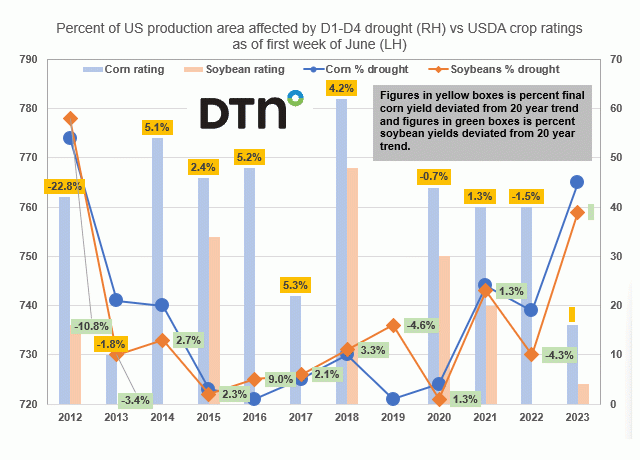Fundamentally Speaking
Percent of US Corn and Bean Area in Drought
The U.S. Drought Monitor site reports statistics about the percentage of growing area that is affected by drought for various agricultural commodities with D1 moderate drought, D2 severe drought, D3 extreme drought and D4 exceptional drought.
This past week it was reported that 45% of the U.S. corn producing area was impacted by D1-D4 drought and 39% of the national soybean area as of the first week of June.
This data series was actually started at the beginning of July 2012, so the current drought percentages are the highest as of the first week of June since this data series was initiated.
P[L1] D[0x0] M[300x250] OOP[F] ADUNIT[] T[]
For comparison we did include the percent of corn and bean area in drought as of the first week of July in that serious drought year of 2012 and all this is reported on the right-hand axis.
On the left-hand axis is the USDA corn crop and soybean crop conditions as of the first week of June using our usual ratings system where we weight the crop based on the percent in each category and assign that category a factor of 2 for very poor, 4 for poor, 6 for fair, 8 for good, and 10 for excellent and then sum the results.
All years for corn from 2012 to this year are included except for 2019, although for soybeans (due to an apparently late-planted crop) there was no crop rating for the first week of June for 2013, 2014, 2016, 2017, 2019 and 2022.
We have also included figures in yellow boxes which are the percent that the final corn yield deviated from the 20-year trend, while numbers in the green boxes are percent soybean yields deviated from 20-year trend.
July is the critical month for corn and August for soybeans but lack of rain in June can certainly hurt as seen in both 1988 and 2012.
This why current corn ratings are the lowest for this time of year since 2013 with bean rating the lowest one as per the first week of June since at least 2011.
(c) Copyright 2023 DTN, LLC. All rights reserved.






Comments
To comment, please Log In or Join our Community .